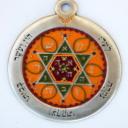Yahoo Answers is shutting down on May 4th, 2021 (Eastern Time) and beginning April 20th, 2021 (Eastern Time) the Yahoo Answers website will be in read-only mode. There will be no changes to other Yahoo properties or services, or your Yahoo account. You can find more information about the Yahoo Answers shutdown and how to download your data on this help page.
Trending News
11 Answers
- NimeshLv 48 years agoFavorite Answer
In almost every Indian home a lamp is lit daily before the altar of the Lord. In All auspicious functions commence with the lighting of the lamp, which is often maintained right through the occasion.Light symbolizes knowledge, and darkness - ignorance. The Lord is the "Knowledge Principle" (Chaitanya) who is the source, the enlivener and the illuminator of all knowledge. Hence light is worshiped as the Lord himself.Knowledge removes ignorance just as light removes darkness. Also knowledge is a lasting inner wealth by which all outer achievement can be accomplished. Hence we light the lamp to bow down to knowledge as the greatest of all forms of wealth. Why not light a bulb or tube light? That too would remove darkness. But the traditional oil lamp has a further spiritual significance. The oil or ghee in the lamp symbolizes our vaasanas or negative tendencies and the wick, the ego. When lit by spiritual knowledge, the vaasanas get slowly exhausted and the ego too finally perishes. The flame of a lamp always burns upwards. Similarly we should acquire such knowledge as to take us towards higher ideals.Appropriate conducts during transition period (Sandhikal) The transition period (Sandhikal) is the period of 48 minutes, that is, two Ghatikas, before the sunrise and after the sunset. The transition period is Raja-Tama predominant. Influence of negative energies is more in this period. Scriptures have described various Conducts (Achars) to be performed in the evening.Lighting black-incense (Dhoop) or incense-stick (Udbatti) in the premises (Vastu).The increased influence of negative energies after sunset pollutes the environment in the Vastu. Distressing vibrations are generated in the Vastu. Light black-incense everyday to remove these distressing vibrations. For lighting black-incense (Dhoop), light coal or cow-dung cake in a specially made vessel for the purpose and place the black-incense (Dhoop) upon it. Hold the vessel in one hand and a cardboard in another, fan the fire with the cardboard to spread the smoke in the Vastu.
Black-incense is generally used in removing the distress caused due to ancestors.Use incense-sticks of Chameli, Heena, Sandalwood and Kevada fragrances. The Saviour (Tarak) or Destroyer (Marak) frequencies of Deities are attracted to the fragrance of these incense-sticks as per the need and negative energies move away. Along with the Vastu, this action also helps in purifying the clothes.
By lighting the black-incense (Dhoop), the Saviour (Tarak) Shiva Principle is activated. Pure (Sattvik) vibrations are attracted in the Vastu. The Purity (Sattvikta) of the Vastu is enhanced. At the same time, the environment of the Vastu is also purified. When the Purity (Sattvikta) is enhanced, the negative energies get troubled and they leave the Vastu. Purity (Sattvikta) of the Vastu is preserved by lighting black-incense daily. If this is not possible, black-incense must be lit at least once a week.
1.2 Light an oil-lamp in front of a Deity, to get protection from the negative energies present in the environment in the evening. At the same time, light a lamp in front of the basil plant (Tulsi) too in the courtyard. By lighting a lamp in front of the Deities, their Principle is awakened and those residing in the Vastu benefit. Science underlying lighting of a lamp in front of the basil plant (Tulsi) in the evening: The evening time is considered to be the time of arrival of the Lakshmi Principle in the Vastu. Tulsi is essentially Sattvik. Principles of various Deities are attracted to the basil plant (Tulsi). By lighting a lamp in front of the basil plant (Tulsi), the Purity (Sattvikta) in it is activated. This Purity (Sattvikta) spreads in the environment present in the Vastu and purifies it. The frequencies of Lakshmi Principle are attracted to the flame of the lamp kept in front of the basil plant (Tulsi) in the purified environment and enter the Vastu. This also purifies the Vastu and a protective sheath of Pure (Sattvik) frequencies of the Deities is created around the Vastu.
•शुभं करोतु कल्याणं आरोग्यं सुखसंपदा |
शत्रुबुद्धिविनाशाय दीपज्योतिर्नमोऽस्तु ते ||
This means, “O flame of the lamp, you are auspicious and benevolent. You provide health and wealth and destroy the intellect of the enemies; hence, I pay my obeisance to you.”
•शुभं करोतु कल्याणं आरोग्यं सुखसंपदाम् |
मम बुद्धिप्रकाशं च दीपज्योतिर्नमोऽस्तु ते ||
“O flame of the lamp, you are auspicious and benevolent. You provide health and wealth. You purify our intellect. We pay our obeisance to you.”
•दीपज्योति:परब्रह्म दीपज्योतिर्जनार्दन: |
दीपो हरतु मे पापं दीपज्योतिर्नमोऽस्तु ते ||
This means, the light of a lamp is a form of Supreme Brahman. The flame of the lamp is a form of the Supreme God, who removes the sorrows of the Universe. “O lamp, eliminate my sins. O flame of the lamp, I pay my obeisance to you.”Benefits of reciting Verses (Shloks):
Source(s): Karmkand Vidhanam Braham Kriya Kalp Kindly read: http://in.answers.yahoo.com/question/index?qid=201... - Anonymous5 years ago
Suhasini puja, also referred as Suvasini Pooja, is a ritual observed during Sharad Navaratri. There is no specific day or date to perform the puja but in some days on Kalasha Sthapana and Durgashtami day, Suhasini Puja is observed. Though, the puja is a common ritual on every Purnima, but during Navaratri days it is auspicious. The pooja involves worshipping a married woman, Sumangali, considering her as a manifestation of Goddess Durga: In some regions, Suvasini pooja is a compulsory ritual during Sharad Navratri As Kumari Pooja, Suhasini Puja is also performed. A married woman is offered meals, fruits, clothes along with dakshina or santarpana and worshipped as the Goddess for the day
- tanakprdLv 68 years ago
That is Indian a way of honouring and expressing gratitude in the form of Lighting Vilakku and inviting
Radiance of Knowledge and chasing away the Darkness of all kinds. More than this .....
- PlatinumLv 78 years ago
My understanding is completely different.
If we see since prehistoric ages, human being is only animal who learned to control and use FIRE,
Initially all human use to lit fire in front of their adobe to keep the wild animals away - because all other animals except Human were afraid of it.
Since last thousands and thousands years all human across world did this activity.
Gradually the fire in front of door transformed itself to different kind of lamp. And instead of wild animals it symbolized to keep evil spirits away.
Using Deep is not only limited to Hindus.
Its used in all religion. Candles are lighted in Churches.
Deep or Diya or Vilaku or Candles are used in all Religions - Hinduism, Islam, Sikhism, Judaism, Buddhism in every religion.
- How do you think about the answers? You can sign in to vote the answer.
- ts@greenpasturesLv 68 years ago
It is common knowledge; that it is with help of light only that we as human beings; not only can see in darkness; but also gain the knowledge about various issues of the things having been seen by us. IT IS A POWERFUL MEDIUM OF GAINING AND GIVING KNOWLEDGE
The mind of self; like us; is also a separate entity; and has an individual identity and sense and knowledge of powerfulness, glory, strengths and attributes of its own. Like us; it also requires knowledge; which it can gain only through a light within.
Our physical eyes; although drive us to see and know the reasons objects, activities, actions, nature and self of the material world only; but the sense and knowledge of the mind of self drives us to see and know the reasons objects, activities, actions, nature and self of the material world; with the help of the traits of Intelligence, knowledge, freedom from doubt and delusion, forgiveness, truthfulness, self-control and calmness, pleasure and pain, birth, death, fear, fearlessness, nonviolence, equanimity, satisfaction, austerity, charity, fame and infamy; of its own.
So long we are lighting a lamp; either with help of fat or ghee of cow's milk or mustard oil; or even with a mentality of devotional service to the lord; either in front of a deity or merely at a sacred place of our worship; and essentially by chanting some common mantras or religious texts, or names of god the lord; either as given to self by our parents down the line through ages; or by gaining them from their creators through their established practitioners; then till such time; the above traits as created by the glory and power of unalloyed devotional service of lord for mankind; not only enlightens the mind and its senses and knowledge; but also as a result removes its darkness as well.
After lighting a lamp and to gain more benefits; one should also read a few pages of any one of the religious scriptures as belonging to the sacredness of the religion of self . This will ensure in all its totality that thereafter our minds will then become able to be driven with the help of those traits as mentioned above only; which are created and belong to the glory and power of unalloyed devotional service of lord for mankind;
- Anonymous8 years ago
NOTHING ! significance, lamp giving just light in darkness
- MaryLv 45 years ago
For the best answers, search on this site https://shorturl.im/xIaI6
1) Suvasini: सुवासिनी suvAsinI f. term of courtesy for a respectable woman whose husband is alive Lalitha Sahasranama Verses 177 & 178: Bandhuka kusumaprakhya bala lila vinodini Sumangali sukhakari suveshadhya SUVASINI .. 177 SUVASINYARCHANA PRITA shobhana shuddha manasa Bindutarpana santushta purvaja tripurambika .. 178 a) Nama 190, SUVASINI: (i) Ever married. Suvasini, a woman whose husband is living ie exempt from widowhood, or Devi is not separate from such women. (ii) She has an immortal husband, Mrtyumjaya, i.e. Shiva. b) Nama 191, SUVASINYARCHANA PRITA: (i) Pleased by the adoration of married women (ii) She is pleased by Her devotees worshiping married women as Her form. (iii) She who is pleased by the worship performed by married women. There are Tantric rites in which married women [sumangalis] are worshipped as Devi. Sri Ramakrishna has done such worship. 2) Suvasini Pooja during Navaratri: A ritual reading (Japa) of the text Devi Mahatmyam, देवीमाहात्म्यम् (other name Durga Saptashati, ढुर्गासप्तशती) is part of the Navaratri celebrations in honour of the Goddess. The text contains 700 (saptashata - "seven hundred") verses, arranged into 13 chapters. The Devi Mahatmyam consists of chapters 81-93 of the Markandeya Purana. Chandi Homam is performed on the last day. With each of the 700 slokas recital, havan is performed and also with the Chandi mantra – ‘Aim Hrim Klim Chamundaye Vichhe’ Suvasini pooja (one sumangali). Kanya Pooja ( nine pre-puberty girls who symbolically represent the nine forms of the goddess Durga) and Dhampathi Pooja (married couple). Their feet are washed,kumkumis applied on the forehead and pooja is done as if they are goddess. they are feasted and given gifts and new clothes by the worshippers. Vaduka pooja (nine Brahmacharis who learn Vedas) is also added in Tamilnadu and some places. In Bihar,Kashmir,Punjab,Uttar Pradesh,Haryana and Bihar Kanya Pooja is popular. Maha Poornahuthi is done at the end. Some do Suvasini pooja daily or any one day preferably on Navami with parayana (recitation) of Devi Mahatmyam daily. 3) Devi Mahatmyam: The evil forces killed by Goddess are Mahishasura, Chanda, Munda, Raktabija , Nisumbha. In "Ya Devi" Hymn also known as Aparajita-stuti or Tantrik Devi Suktam (Chapter 5): At the beginning of the third episode, when the beleaguered gods recall the Goddess's promise to assist them, they head to Mount Himavan and there offer a hymn to the Goddess. ‘ya devi sarvabhuteshu buddhi ruprena samstithanamastasyai namastasyai namastasyai namo namah ya devi sarvabhuteshu nidra ruprena samstithanamastasyai namastasyai namastasyai namo namah ya devi sarvabhuteshu kshudhaa ruprena samstithanamastasyai namastasyai namastasyai namo namah ya devi sarvabhuteshu cchayaa ruprena samstithanamastasyai namastasyai namastasyai namo namah ya devi sarvabhuteshu shakti ruprena samstithanamastasyai namastasyai namastasyai namo namah ya devi sarvabhuteshu trshnaa ruprena samstithanamastasyai namastasyai namastasyai namo namah ya devi sarvabhuteshu kshanti ruprena samstitha namastasyai namastasyai namastasyai namo namah ya devi sarvabhuteshu shraddhaa ruprena samstithanamastasyai namastasyai namastasyai namo namah ya devi sarvabhuteshu kaanti ruprena samstithanamastasyai namastasyai namastasyai namo namah ya devi sarvabhuteshu lakshmi ruprena samstithanamastasyai namastasyai namastasyai namo namah ya devi sarvabhuteshu vrtti ruprena samstithanamastasyai namastasyai namastasyai namo namah ya devi sarvabhuteshu smrti ruprena samstithanamastasyai namastasyai namastasyai namo namah ya devi sarvabhuteshu dayaa ruprena samstitha namastasyai namastasyai namastasyai namo namah ya devi sarvabhuteshu tushti ruprena samstithanamastasyai namastasyai namastasyai namo namah ya devi sarvabhuteshu maatr ruprena samstitha namastasyai namastasyai namastasyai namo namah ya devi sarvabhuteshu bhraanti ruprena samstithanamastasyai namastasyai namastasyai namo namah’ "O Divine Mother who dwells in the hearts of all beings as consciousness, intelligence, desire, craving, sleep, hunger, reflection, power, thirst, forgiveness, genius, modesty, peace, faith, loveliness, good fortune, activity, memory, compassion, contentment, mother, madness, confusion and error - I salute Thee." 4) Edited: The answerer is in the organising committee of Sri Sadguru Sadhashiva Brahmendral Aradhana at Manamadurai where Suvasini pooja (one sumangali), Kanya Pooja (nine girls), Vaduka pooja (nine Brahmacharis) and,Dhampathi Pooja ( now fifty couples) are done on the Aradhana Day (Vaishakha Shukla Pradamai) for the past 25 years. Mangali poondu (sumangali prarthanai): This is done to invoke to seeking the blessings of the ancestral women of the family who left this world as sumangalies. The total number of Sumangalies should be 3, 5, 7,..... This ritual is done during marriage and upanayanam like samskaras.
- ?Lv 78 years ago
appane! shanmugaa! gnana pandithaa ! naan um sannadhiyioa vilakku yettharen nee en vaalkkziyila oli yetthappaa!
dharumi
kaalaiyum maalaiyum velai aarambikkaradhukku munne, velai mudicha pinne mana niraivoda irukkira
time aam








